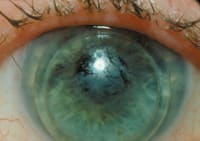contact lens care
A Clean Lens is
a Comfortable Lens
BY MICHAEL A. WARD, MMSC, FAAO
In the last few years, we've increasingly recognized and managed contact lens-associated discomfort related to contact lens and care product incompatibilities or solution-related toxicities. What was then an under-recognized solution-related complication is now an over-diagnosed entity. Occasionally, a clinical challenge reminds us that we need to pay attention to contact lens basics: good hygiene and proper care product selection.
|
|
|
|
Figure 1. GP lens with filmy deposits and non-wetting
spots.
|
|
Case Report
A 43-year-old male GP lens wearer presented for evaluation and management complaining of ocular burning, dryness, foggy vision and decreased contact lens wearing time. His symptoms had started insidiously approximately nine months earlier. He'd successfully worn GP lenses for more than 10 years.
The patient's recent eyecare practitioner had suggested that his irritation resulted from allergy to lens care products. Since then, the patient has purchased new lenses and has tried three different lens care regimens in the last six months. His symptoms improved temporarily, but have now worsened. He was currently using an all-in-one lens care product.
Looking Beyond the Solution
Slit lamp evaluation revealed significant debris accumulation and associated non-wetting spots on his GP lens surfaces (Figure 1). His corneas were clear except for occasional inferior punctuate stain. His tear film was thick and heavily laden with cellular debris. The meibomian orifices were full and a sudsy froth was evident on his lid margins. His tear meniscus appeared normal.
We diagnosed this patient with meibomian gland dysfunction (MGD) with associated lens coating/debris (dirty lenses). His current lens care system was inadequate.
We successfully managed this case by:
- Cleaning and polishing his lenses, including treating them with Progent (Menicon), an effective in-office GP lens chemical cleaning system.
- Adding a daily cleaner and weekly enzymatic cleaner to his lens care regimen.
- Managing his MGD with hot compresses and lid hygiene.
Clean = Comfortable
The cleaning and polishing of the patient's GP lenses brought immediate relief to his symptoms. Now the key was to keep them from returning.
His GP multipurpose solution (MPS) was inadequate for keeping his lenses clean. The surfactants in MPS products are necessarily mild because the solution goes directly in the eye. However, the patient liked the lower viscosity of the MPS product for lens wetting. This wasn't a problem. He could continue to use the MPS product for lens storage/disinfection and wetting, but we needed to augment his system with a strong daily lens cleaner (used in the evening immediately following lens removal) and weekly (liquid) enzymatic cleaning.
Daily use of hot compresses to his eyelids along with regular lid hygiene nicely managed his mild MGD. He had no complaints at his last follow-up visit and his lenses remained clean. This was a clinical reminder that a clean contact lens is a comfortable contact lens.
Mr. Ward is an instructor in ophthalmology at Emory University School of Medicine and Director, Emory Contact Lens Service.




